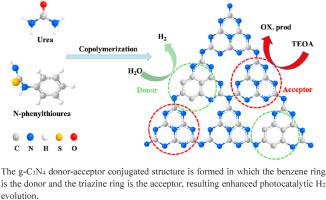当前位置:
X-MOL 学术
›
Renew. Energy
›
论文详情
Our official English website, www.x-mol.net, welcomes your
feedback! (Note: you will need to create a separate account there.)
Incorporation of π-conjugated molecules as electron donors in g-C3N4 enhances photocatalytic H2-production
Renewable Energy ( IF 9.0 ) Pub Date : 2021-02-01 , DOI: 10.1016/j.renene.2020.09.040 Runren Jiang , Guanghua Lu , Jianchao Liu , Donghai Wu , Zhenhua Yan , Yonghua Wang
Renewable Energy ( IF 9.0 ) Pub Date : 2021-02-01 , DOI: 10.1016/j.renene.2020.09.040 Runren Jiang , Guanghua Lu , Jianchao Liu , Donghai Wu , Zhenhua Yan , Yonghua Wang

|
Abstract Reinforcing migration of charge carrier in g-C3N4 photocatalytic system is critical for photocatalytic H2 evolution. Herein, we constructed a benzene-ring-incorporated g-C3N4 by copolymerization of urea with N-phenylthiourea. A π electron donor-acceptor conjugated structure is formed in which benzene ring is the donor while triazine ring is the acceptor. It is noteworthy that ultrafast transient absorption spectroscopy and density functional theory calculation were applied to gain more insight into the properties of the benzene ring with g-C3N4 as the electron donor in the triazine ring. As expected, the introduction of the benzene ring into triazine ring of the g-C3N4 displayed extraordinarily aggrandized hydrogen evolution, which not only crucially modified the π electronic structures and promote π-electron availability, but also played the role of a donor to improve the electron-hole separation. This study revealed that the photocatalytic H2 evolution of the donor-acceptor system can be further improved by inserting suitable π-conjugated as one of the units.
中文翻译:

在 g-C3N4 中加入 π 共轭分子作为电子供体可增强光催化制氢
摘要 加强 g-C3N4 光催化体系中载流子的迁移对于光催化析氢至关重要。在此,我们通过尿素与 N-苯基硫脲的共聚反应构建了掺入苯环的 g-C3N4。形成π电子供体-受体共轭结构,其中苯环为供体,三嗪环为受体。值得注意的是,应用超快瞬态吸收光谱和密度泛函理论计算以更深入地了解以 g-C3N4 作为三嗪环中电子供体的苯环的性质。正如预期的那样,将苯环引入 g-C3N4 的三嗪环中显示出异常加剧的析氢,这不仅关键地改变了 π 电子结构并促进了 π 电子可用性,但也起到了施主的作用,以改善电子空穴分离。该研究表明,通过插入合适的π-共轭作为单元之一,可以进一步改善供体-受体系统的光催化析氢。
更新日期:2021-02-01
中文翻译:

在 g-C3N4 中加入 π 共轭分子作为电子供体可增强光催化制氢
摘要 加强 g-C3N4 光催化体系中载流子的迁移对于光催化析氢至关重要。在此,我们通过尿素与 N-苯基硫脲的共聚反应构建了掺入苯环的 g-C3N4。形成π电子供体-受体共轭结构,其中苯环为供体,三嗪环为受体。值得注意的是,应用超快瞬态吸收光谱和密度泛函理论计算以更深入地了解以 g-C3N4 作为三嗪环中电子供体的苯环的性质。正如预期的那样,将苯环引入 g-C3N4 的三嗪环中显示出异常加剧的析氢,这不仅关键地改变了 π 电子结构并促进了 π 电子可用性,但也起到了施主的作用,以改善电子空穴分离。该研究表明,通过插入合适的π-共轭作为单元之一,可以进一步改善供体-受体系统的光催化析氢。











































 京公网安备 11010802027423号
京公网安备 11010802027423号